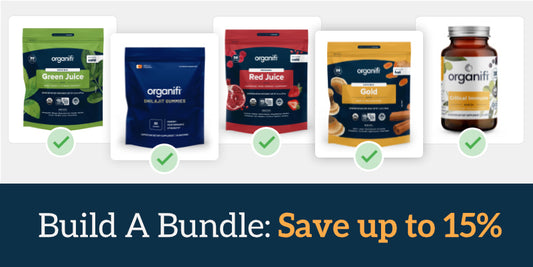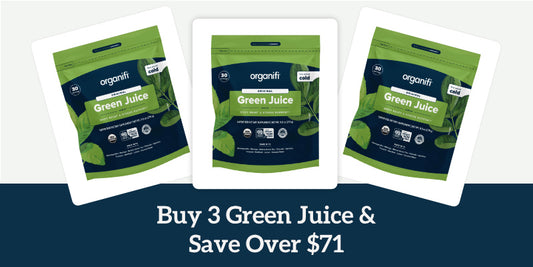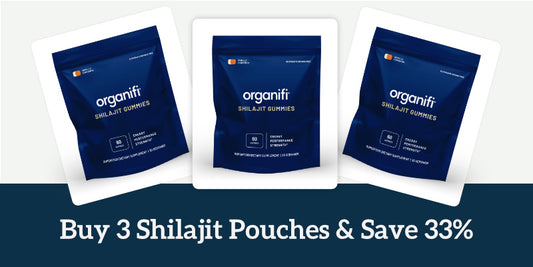Adding foods high in probiotics to your diet could improve your overall health in a matter of 4-6 weeks. We’ve even seen it happen slightly faster when people pair their probiotic supplements with other healthful nutrition choices - like our superfood drink mixes, plenty of greens, and other whole foods. But even alone, probiotics may support digestion, help clear skin, reduce gas and belly-bloat, boost immunity, and even contribute to a good mood.
Do we have your attention now?
Probiotics are health-supporting bacteria that already live in your digestive tract, but that may become depleted due to poor diet, excess sugar, toxins in food or the environment, food poisoning, alcohol consumption, antibiotic use, and more.
You can replenish your body’s reserves with both food and supplements, but we really recommend both. That’s the best way to ensure you are getting a good mix of probiotic strains and the right quantity of these helpful gut bacteria. To get you started, we put together a “who’s who” of foods high in probiotics, comparing some of the choices you may face in the grocery store aisle, to make your next shopping trip easy-peasy and your gut extra happy.
Why Eat Probiotic-Rich Foods?
To understand why foods high in probiotics help you, we must first answer: what are probiotics?
Probiotics, from the Greek “pro” for “promoting” and “bio” for “life,” are live microorganisms that provide health benefits when consumed by growing or restoring intestinal flora.
The gut microbiome hosts trillions of bacteria, yeast, fungi, and more, that live in perfect harmony under the right conditions. When unbalanced, it can result in a multitude of health issues. You see, these bacteria don’t just help digestion; they also support the brain and the immune system. Seriously! That means foods high in probiotics are more than just a “nice-to-have.”
Probiotics in the gut microbiome:
- May control what is absorbed and what is excreted
- Can help metabolize fat
- May help remove harmful substances
- May keep “unfriendly” bacteria and yeast (like Candida) growth in check
- Can reduce infections
- Can help prevent chronic inflammation
- May influence the body’s production of serotonin (the “happiness” hormone)
- Can regulate bowel movements
- More!
With over 500 different species living in the gut, competition for the ecosystem is inevitable. Foods high in probiotics make sure that the bacteria strains found to have positive results continue to grow and outnumber the “unfriendly” ones.
The Ultimate List of Foods High in Probiotics
There are natural ways to get probiotics: you can find them in dairy products, fermented foods, and probiotic-fortified foods. Alternatively, you can find them in supplements, like you do vitamins.
But, when it comes to food: which ones are better and have more?
Dairy Products:
Of the foods high in probiotics, dairy is still king. Probiotics were first observed in yogurt and, to this day, remain as one of the most reliable natural sources for them.
- Yogurt
- Kefir
- Skyr
- Raw cheese (unpasteurized)
- Raw milk (unpasteurized)
- Cultured or Traditional Buttermilk
Here’s how they stack against each other:
Yogurt vs. Kefir vs. Skyr
Sold as nearly identical sources of probiotics, they’re not the same - even in taste and texture.
-
Yogurt: is made out of milk fermented by “good” bacteria like Bifidobacterium and lactic acid. It’s often fortified with even more colony-forming units of the Lactobacillus and the Bifidum family. Regular brands boast 90 to 150 billion CFUs per gram.
-
Kefir: made with low-fat “milk” produced out of kefir grains, which are actually a combination of 10 to 20 types of lactobacillus bacteria and yeasts. It has three times more probiotics culture than yogurt.
- Skyr: this Icelandic cheese tastes and feels a lot like Greek yogurt, and it’s made out of skim milk, making it lower in fat but richer in probiotics and protein compared to regular yogurt. Usually with 14 different strains and an average of 10 billion CFUs.
The Verdict:
Kefir may be the best source of probiotics when compared to yogurt and skyr.
It’s also important to note that some colony-forming units may die in transit to the gut due to stomach acids. So, even though all yogurt has live bacteria in it, the fortified ones may provide better results.
If you’re lactose-intolerant, choose Skyr as it is naturally lactose-free, unlike yogurt or kefir. And for vegans, there may be fortified coconut milk or soy milk-based products that help get you the same benefits of probiotics.
Raw Cheese vs. Raw Milk vs. Buttermilk
-
Raw (or Unpasteurized) Cheese: may be one of the lesser-known foods high in probiotics, research shows it is a viable bio-carrier that could supplement probiotic needs in humans. Their low acidity and high-fat content help live culture bacteria as they go through the digestive tract. They offer a similar count and strain combination (Bifidobacterium and Lactobacillus) as yogurt.
- Raw Milk: unpasteurized milk may have significant probiotic content, as it is produced from free-range, organic-fed cows. However, the FDA does not recommend raw milk consumption, and it won’t be possible to find this in your local grocery store.
- Buttermilk: a naturally fermented byproduct of the milk churned to make butter. Almost equal to Kefir in probiotic content, it’s only good fresh. This means the supermarket ones do not have any live bacteria left in them.
The Verdict:
Unpasteurized cheese might be the safest source of probiotics after kefir and yogurt or Skyr.
Buttermilk is high in live culture content, but difficult to access in its pure form - and raw milk may not be safe for humans. You can also add Cheddar, Feta, Gouda, Emmental, Edam, Gruyere, or Caciocavallo to your diet in moderation.
Fermented Foods
Vegan? Lactose-Intolerant? Not into dairy? No problem! These foods high in probiotics have nothing to do with milk or animal byproducts.
- Sauerkraut
- Tempeh
- Natto
- Kimchi
- Miso
- Kombucha
- Pickles or Gherkins
- Water or Brine-cured olives
- Kvass
- Apple Cider Vinegar
- Water Kefir
- Dairy-free Fortified Yogurt
Choosing which is best? It’s not as easy as with dairy products, and they’re all considered great sources of healthy bacteria.
Researchers have tried to rank foods high in probiotics, concluding that while Kefir seems to offer the most per serving, there's not enough data for a definitive rank for the rest. The sheer number of live cultures and ingredients in each food make them too heterogeneous to study accurately.
Nevertheless, here’s our take:
Sauerkraut Probiotics vs. Kimchi vs. Pickles
In this mano-a-mano of fermented foods high in probiotics, we decided to group them by similarities. These are you pickled veggies:
-
Sauerkraut probiotics rank #3 in variety according to this review. They come from fermented cabbage and its organic acid content supports “friendly” bacteria growth. Sauerkraut probiotics may rise to one trillion or more CFU per gram.
-
Kimchi is a typical Korean fermented side dish made out of mostly cabbage, and other vegetables; reportedly, it may contain lactic acid bacteria, Leuconostoc, Weissella, and Lactobacillus as probiotics.
- Pickles are cucumbers pickled in salt and water that, after a while, ferment in their lactic acid and become sour. Cucumbers pickled in vinegar do not have live culture left.
The Verdict:
These are not at the top of our foods high in probiotics. Nevertheless, it seems that sauerkraut probiotics beat kimchi in variety. Still, kimchi may have a higher concentration per 100 grams. We would say these two are tied for the top, both beating probiotic pickles - the least studied of the three.
However, due to the amounts you’d have to eat daily to see results (about 100g per day), these are not our “go-to’s” for all your probiotics needs.
Instead, we recommend adding them in for variety or making sure you keep up with a daily probiotic supplement to ensure your gut is getting all it needs!
Tempeh vs. Nato vs. Miso.
-
Tempeh is made out of fermented soybeans. The fermentation process turns tempeh into a powerhouse of minerals and vitamins like B12, calcium and magnesium. Depending on the source it could provide up to 10 billion CFU per gram.
-
Nato is another fermented soy byproduct, tends to be rich in Bacillus subtilis probiotics, and provides anything from 1 million to 1 billion CFUs per gram. Unfortunately, when you’re looking for foods high in probiotics, this one is hard to find.
- Miso is also fermented soy; fermentation gives it more vitamins and minerals and an average of 100 billion probiotics CFUs per gram.
The Verdict:
These are all good sources of probiotics, but due to their soy content, they could affect people who are goitrogen-sensitive, have soy allergies or thyroid issues. Out of the three miso and tempeh, offer the highest live culture content and are easier to get than nato.
Kombucha vs Apple Cider Vinegar
-
Kombucha is a fermented black or green tea. It has high sugar content from the fermentation and could have up to 10 billion CFU per gram. It’s an unexpected probiotic tea, but very common in Asia and quickly emerging in the US.
- Apple Cider Vinegar is another popular ingredient of probiotic tea, it is a highly contested probiotic food because only the “mother” base counts. As a result, it may be beneficial to overall health, but it may not necessarily add a high live culture count to your diet.
The Verdict:
Kombucha is the clear winner when compared to ACV; however, for a probiotic tea, it is very high in sugar and may have negative side-effects for people on a Candida diet or looking to reduce this type of yeast. Drink up, but keep an eye on your sugar intake!
Probiotic Strains To Look For:
Foods high in probiotics won’t always say which helpful bacteria strains they have unless they are fortified. In general, it’s good to aim for a mix of positive bacteria strains and whenever possible support your dietary needs with probiotic supplements like probiotic tea, powder, or capsules that contain some of these:
- Lactobacillus acidophilus
- Bifidobacterium bifidum
- Bacillus subtilis
- Lactobacillus bulgaricus
- Lactobacillus reuteri
- Streptococcus thermophilus
- Saccharomyces boulardii
Recommended Dose of Probiotics
Some believe the higher the number, the better because more colony-forming units have the opportunity to reach the intestine alive and grow.
Unfortunately, there is no evidence to support this or the contrary. Consumers are recommended to focus instead on a variety of strains and the date on the supplement, as the bacteria needs to be alive to provide health benefits. Foods high in probiotics should also be eaten as fresh as possible.
According to Harvard Health, a healthy individual benefits from: 1 billion to 10 billion colony-forming units (CFU) or probiotics in foods or supplement form, several days per week.
For antibiotic-related diarrhea or stomach flu, two weeks of supplements could help restore your gut health a bit faster than food, but you should look for certain strains and dosages according to your physician's recommendation.
In Conclusion:
Foods high in probiotics may help balance gut bacteria, which is necessary to lead a healthy life. However, given that it’s hard to track which ones have more probiotic colony-forming units or strains, it’s advisable to try a probiotic tea or supplement to get their benefits efficiently.
Consistency is vital to see results. Consult with your doctor to see if any medication or treatment you’re currently on could be affected by live culture bacteria, they’re generally safe, but it’s always better to check.




